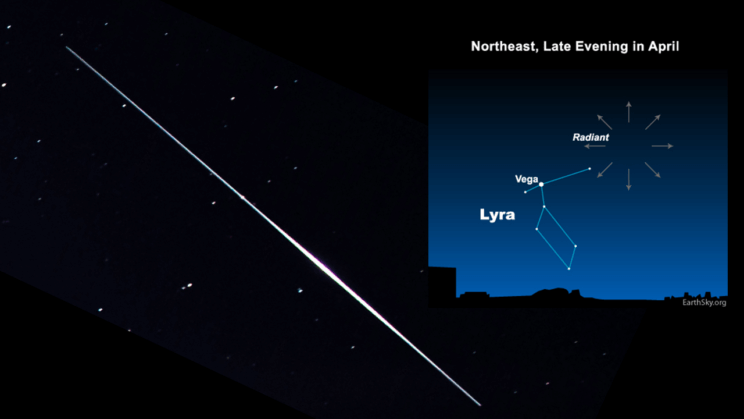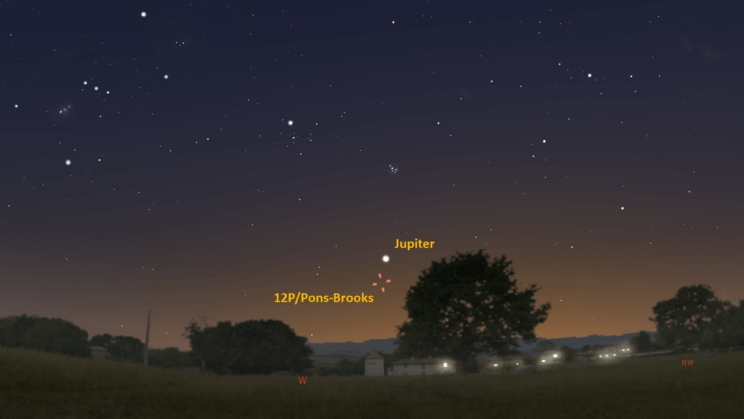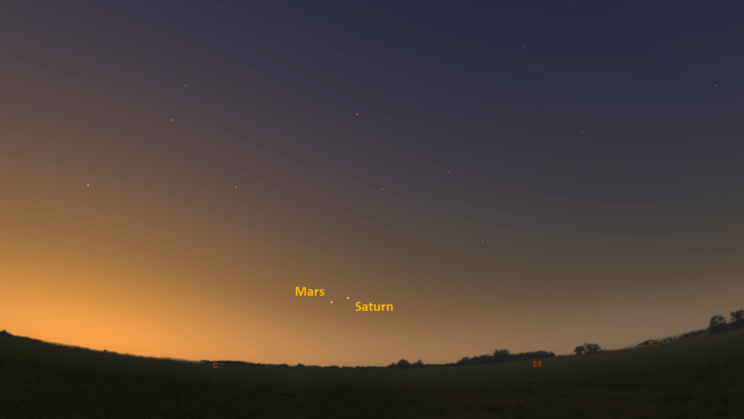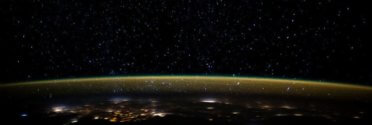This is the Saint Louis Science Center’s NIGHT SKY UPDATE for the week of Saturday, April 13, 2024.
Information updated weekly or as needed.
Times given as local St. Louis time this week will be in Central Daylight Time (CDT). For definitions of terminology used in the night sky update, click the highlighted text. If relying on times posted in Universal Time (UT), St. louis is -5 hours when CDT.
Join us for our next star party, Friday, June 7, 2024, held in association with the St. Louis Astronomical Society. For details, see the information at the bottom of this page or visit https://www.slsc.org/explore/mcdonnell-planetarium/public-telescope-viewings/
Observing Highlight of the Week

On left, a Lyrid meteor is seen smashing into Earth’s atmosphere. Image credit: PsamatheM. On right, a map showing the radiant of the Lyrid meteor shower near the constellation Lyra. Image credit: Bruce McClure and Joni Hall – EarthSky.org
On April 15, 2024, Earth will encounter debris from comet C/1861 G1 (Thatcher). This occurs every year around the same time marking the start of the annual Lyrid meteor shower. This moderate shower lasts from April 15 to April 29 with peak activity occurring on April 22, 2024.
The Lyrids are expected to produce a peak rate of 18 meteors per hour. Typically, the Lyrids produce decent rates for three nights centered on the date of peak activity. Unfortunately, this year, the Moon will interfere with these displays as it will shift from first to last quarter phase during the meteor shower’s duration. During the three nights of increased activity, the Moon will exhibit 96% to 100% disk illumination from April 21 to April 23.
Even though moonlight will interfere, it is still worth sitting outside for a while as the Lyrids often produce brighter meteors. The ideal time frame to see meteors is from midnight to 5:00 a.m. There is no specific part of the sky to look at, but you do want to know where the radiant for the Lyrids is found. This is the point in the sky where meteors emanate from. Meteors will be seen in all directions but their paths trace back to the location of the radiant. Its position in the sky determines where you will see meteors. If you cannot observe this late, the Lyrid radiant is rising by 10:00 p.m. in the northeast. This is not the ideal time to look for meteors, but you may see a few emanating for the northeastern horizon as the radiant rises.
The second half of the year is when most of the good meteor showers occur, however, most of these will be impacted by moonlight in 2024. A good place to learn more about the Lyrids and other meteor showers is the American Meteor Society.
Comet 12P/Pons-Brooks Update
For those interested in observing periodic comet 12P/Pons-Brooks, it can still be found in the west by 8:20 p.m. Currently, the comet is found in the constellation Aries with magnitude estimates from 4.0 to 4.4. At this magnitude urban viewers might be able to spot the comet with binoculars, but city lights will make it difficult. If you are in darker skies, the comet should be easy to find. I have seen the comet using 8×56, 10×50 and 8×28 binoculars from suburban skies. As we approach the comet’s perihelion on April 21, 2024, it should continue to brighten. There are several resources online that can provide maps of the comet’s location. I use the software Stellarium to see the star field the comet is in each night. This will be the last week we can easily find the comet after sunset. As the comet approaches perihelion on April 21, 2024, it will appear lower to the horizon each night.
The Sun and Moon

The Moon as seen from the International Space Station, on July 31, 2011.
Credit: NASA
Sun
Sunrise is at 6:27 a.m. on Saturday, April 13 and sunset is at 7:36 p.m. providing roughly 13 hours of daylight this week. By the end of the week, it will be around 13.5 hours of daylight. Even after sunset, light from the Sun will dimly illuminate our sky for about 1 hour and 40 minutes. This period is called twilight, which ends around 9:11 p.m. this week. For those with a sundial, local noon occurs around 1:01 p.m. on April 13, 2024.
| Day | Sunrise | Sunset | ||||||||||
|---|---|---|---|---|---|---|---|---|---|---|---|---|
| 13-Mar | 6:27 a.m. | 7:36 p.m. | ||||||||||
| 14-Mar | 6:25 a.m. | 7:37 p.m. | ||||||||||
| 15-Mar | 6:24 a.m. | 7:38 p.m. | ||||||||||
| 16-Mar | 6:22 a.m. | 7:39 p.m. | ||||||||||
| 17-Mar | 6:21 a.m. | 7:40 p.m. | ||||||||||
| 18-Mar | 6:19 a.m. | 7:41 p.m. | ||||||||||
| 19-Mar | 6:18 a.m. | 7:42 p.m. | ||||||||||
| 20-Mar | 6:17 a.m. | 7:43 p.m. | ||||||||||
| 21-Mar | 6:15 a.m. | 7:44 p.m. |
Moon
Moonrise for Saturday, April 13 was at 9:42 a.m. and moonset occurs at 1:43 a.m. on the following day. On Saturday, April 13, the Moon will exhibit a waxing crescent phase with roughly 32% disk illumination. By the end of the week the Moon will exhibit a waxing gibbous phase with 96% disk illumination. First quarter moon for April occurs on April 15, 2024, at 2:13 p.m.
International Space Station (ISS) Observing

There are several visible passes of ISS from St. Louis for the week of April 13. They occur during morning hours. The table below lists the best of these passes that will be seen from St. Louis. If you do not live in the area, you can use https://heavens-above.com/ to set your viewing location and get times for where you are.
Catch ISS from St. Louis starting Saturday, April 13, 2024
| Date | Starts | Max. altitude | Ends | |||||||
|---|---|---|---|---|---|---|---|---|---|---|
| Time | Alt. | Az. | Time | Alt. | Az. | Time | Alt. | Az. | ||
| 19 Apr | -2.4 | 5:30:40 | 10 | SSW | 5:33:44 | 35 | SE | 5:36:48 | 10 | ENE |
| 21 Apr | -3.8 | 5:30:01 | 13 | WSW | 5:32:55 | 74 | NW | 5:36:14 | 10 | NE |
Magnitude (Mag): The Measure of brightness for a celestial object. The lower the value is, the brighter the object will be.
Altitude (Alt): The angle of a celestial object measured upwards from the observer’s horizon.
Azimuth (Az): The direction of a celestial object, measured clockwise from an observer’s location with north being 0°, east being 90°, south being 180° and west being 270°.
Detailed information regarding all unmanned exploration of our universe, missions past, present, and planned, can be found at Jet Propulsion Laboratories:
The Visible Planets

Looking west at 8:20 p.m. on April 13, 2024. Credit: Stellarium, EG

Looking east at 5:50 a.m. on April 14, 2024. Credit: Stellarium, EG
This week, one naked eye planet is easily seen. Jupiter is visible in the west once it is dark. Mars and Saturn are becoming visible in the east before sunrise, but trees will likely still obscure their view.
Mars
Over the last month, Mars has slowly begun to climb out of the Sun’s glare. For most, the red planet will still be difficult to find. Mars is found about 8.5° above the eastern horizon 30 minutes before sunrise. The twilight glare and tress will be an issue.
Jupiter
Jupiter is now the only planet easily seen during evening hours. You can find Jupiter about 30 minutes after sunset, in the western sky. Jupiter sets around 9:37 p.m. this week. Jupiter’s current apparition is coming to an end as it heads towards superior conjunction on May 18, 2024.
Saturn
Like Mars, Saturn has been climbing out of the Sun’s glare in the east before sunrise. It may be too low for some to see, however, 30 minutes before sunrise Saturn will be roughly 8.5° above the eastern horizon.
Our next Star Party will be held on Friday, June 7, 2024, from dusk until 9 p.m.
As part of the Saint Louis Science Center’s First Fridays, weather permitting, the St. Louis Astronomical Society and the Science Center will set up a number of telescopes outdoors and be on-hand to answer your questions. Telescope viewing begins once it is dark. Regardless of the weather on June 7, join us indoors in our planetarium theater for “The Sky Tonight”. Showtime is at 7 p.m. This free, indoor star program will introduce you to the current night sky. Doors open 15 minutes before show time. Shows begins at 7 p.m. Sorry, no late admissions due to safety issues in the darkened theater.
The St. Louis Astronomical Society helps host the monthly Star Parties at the Saint Louis Science Center which are held on the first Friday of each month. Our Monthly Star Parties are open to the public and free of charge.
James S. McDonnell Planetarium
Night Sky Update: April 13, 2024







